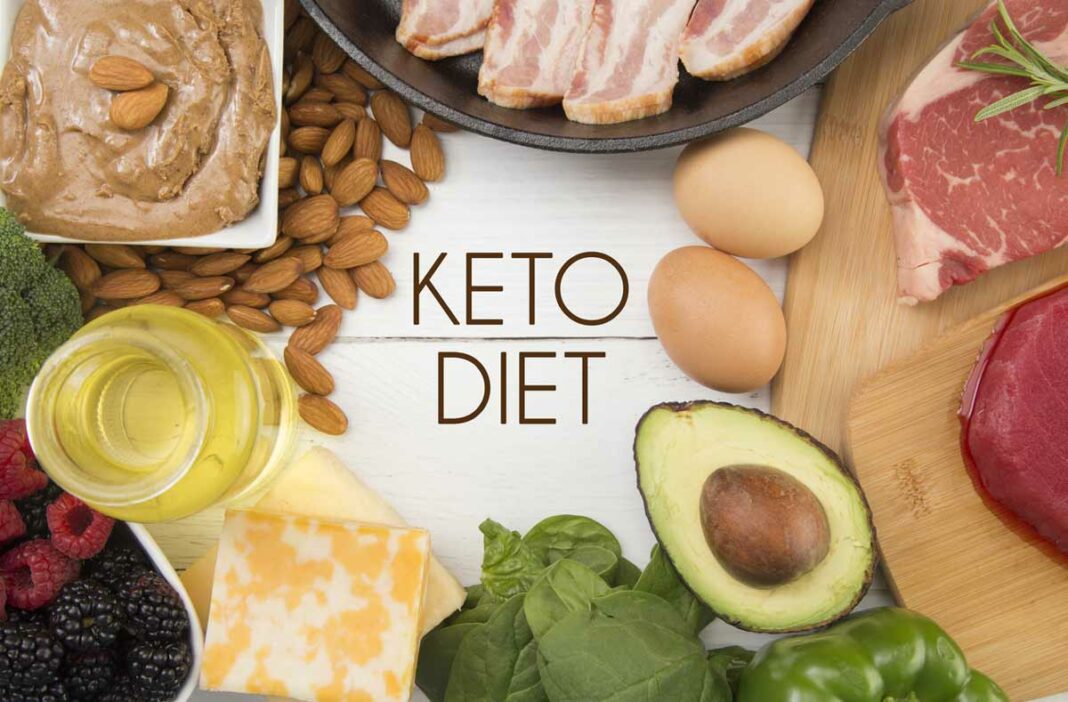A ketogenic diet, sometimes known as the keto diet, is a low-carb eating plan that can help you lose weight. Over 50 studies have shown that it has various established benefits for weight loss, health, and performance. As a consequence, it is being recommended by an increasing number of doctors and health professionals. Just like how we recommend Thunderbolt online casino for all your online gambling needs!
A ketogenic diet can aid weight loss without deprivation while also improving type 2 diabetes and metabolic syndrome.
If you are starting in the world of diets and want to learn more about the Keto diet, then we will teach you everything you need to know about the Keto diet.
What is a keto diet?
A keto diet consists of a high-fat, low-carbohydrate diet. It’s quite similar to other low-carb diets.
On a keto diet, you consume fewer carbs, a moderate amount of protein, and maybe more fat. When you cut carbohydrates, your body enters a metabolic condition known as ketosis, in which fat (from your body and what you eat) is used for energy.
Meaning of “keto”
The term “ketogenic” refers to the diet that permits the body to produce little fuel molecules known as “ketones.” The body uses a different type of fuel when blood sugar (glucose) levels are low.
When there aren’t enough carbs or calories in the diet, the liver produces ketones from fat. The entire body, especially the brain, receives energy from ketones.
The brain is a voracious organ that consumes a lot of energy on a daily basis and cannot function just on fat. It’ll only function with glucose…or ketones.
The entire body alters its fuel supply to run largely on fat on a ketogenic diet; fat is burned 24 hours a day, seven days a week. Fat burning can be dramatically boosted when insulin levels are very low. It gets easier to access and burn stored fat in the body.
This is beneficial if you’re trying to lose weight. But there are also other advantages, such as feeling less hungry and having a continuous flow of energy without the sugar spikes and crashes that are accompanied with high-carb meals. This may assist you in being attentive and concentrated.
When the body creates ketones, it enters a metabolic state known as ketosis. Fasting (going without food) is the quickest way to get into ketosis, yet no one can fast permanently.
A keto diet, on the other hand, leads to ketosis and can be followed for the remainder of one’s life. Many of the advantages of fasting, such as weight loss, can be achieved without fasting for long periods of time.
Who should NOT follow a ketogenic diet?
The keto diet is not without its myths and debates, but it appears to be very safe for the majority of people.
There are three types of persons, however, who require special attention:
- If you take diabetes medications, for example, insulin.
- If you take medication for high blood pressure.
- If you are breastfeeding.
What to eat on a keto diet
Try to avoid
This is what you should avoid on a keto diet: carbohydrates that contain a lot of sugar and starch. This includes starchy foods like bread, pasta, rice, and potatoes. These foods are extremely high in carbohydrates.
Amounts are grams of net carbs per 100 grams (3.5 oz), unless otherwise noted.
Low-fat diet products should also be avoided. A keto diet should be relatively high in protein and perhaps a little higher in fat, as the fat will provide you with the energy that carbs no longer provide. Low-fat foods are typically abundant in carbs with little protein and fat.
What to drink
So, on a ketogenic diet, what can you drink? Water is the ideal beverage, however, coffee or tea will suffice. It is preferable to avoid using sweeteners, particularly sugar.
It’s fine to use a modest amount of milk or cream in your coffee or tea (but avoid lattes!). It’s also fine to go for a glass of wine now and then.
To get into ketosis, the most crucial thing is to avoid eating too many carbohydrates. You’ll probably need to limit your carb intake to less than 50 grams of net carbs per day, preferably less than 20 grams.
The fewer carbs you consume, the higher your chances of ketosis, weight loss, and type 2 diabetes reversal appear to be.
Initially, counting carbohydrates may be advantageous. If you stick to the meals and dishes we provide, you can stay keto without tracking calories.
Why eat a keto diet? The health benefits
You’re more likely to establish ketosis, lose weight, and reverse type 2 diabetes if you eat fewer carbs.
Lose weight
Transforming your body into a fat-burning machine can help you lose weight. The ability to burn fat has greatly enhanced, while insulin levels have significantly decreased.
This appears to make shedding body fat without starvation a lot simpler.
Over 30 high-quality research papers have shown that low-carb and keto diets are more effective than other diets.
Appetite control
If you follow a ketogenic diet, you’ll most likely gain new control over your hunger. According to studies, it is rather common for the sensation of hunger to decrease significantly.
Wait till you’re hungry to eat; this will help you lose weight by allowing you to eat less.
It also facilitates intermittent fasting, which can help you reverse type 2 diabetes and lose weight more quickly than the keto effect alone.
Furthermore, not having to constantly nibble could save you time and money. Many people on the keto diet only need to eat twice a day (often skipping breakfast), while others only need to eat once.
Not having to fight hunger might also help with difficulties like sugar or food addiction treatment.
Happiness, at the very least, could be a part of the solution. Depending on your inclinations, food can either become your buddy or simply feed you.
Controls blood glucose and reverses type 2 diabetes
There are studies that prove that a ketogenic diet is excellent for the management of type 2 diabetes, and sometimes even leads to reversing the disease.
It makes a lot of sense since the keto diet lowers blood sugar levels, reduces the need for medication, and reduces the potentially negative impact of high insulin levels.
Since a keto diet can even reverse existing type 2 diabetes, it is likely to be effective in preventing or reversing pre-diabetes.
Note that in this context the term “reverse” simply means that the disease improves, glucose control is improved, and the need for medication is reduced.
In the best of cases, the improvement can be so great that the glycaemia (blood sugar) is maintained at normal levels in the long term, without any need for medication. In this context, reversing means the opposite of the disease progressing or getting worse.
However, these lifestyle changes only work as long as you stick with them. If a person returns to the lifestyle they had before type 2 diabetes developed and progressed, over time the disease is likely to return and progress again.
Improvement in health markers
Many studies show that low-carbohydrate diets improve several important risk factors for heart disease, including cholesterol profile (HDL, triglycerides), while total and LDL cholesterol levels are generally slightly affected.
It is also typical to see improved levels of glycaemia (blood sugar), insulin and blood pressure.
These markers that commonly improve are connected to what is called the “metabolic syndrome” and improve weight, waist circumference, reversal of type 2 diabetes, etc.
Energy and mental performance
Certain people who seek to boost their mental functioning utilize ketogenic diets. Furthermore, when people are in ketosis, they often experience an increase in energy.
The keto diet eliminates the brain’s need for dietary carbohydrates. It eats ketones and a small amount of glucose produced by the liver to stay alive. It is thus not essential to take carbohydrates.
As a result, ketosis maintains a steady supply of fuel (ketones) to the brain, avoiding the issues associated with blood sugar swings.
This can sometimes result in enhanced attention and concentration, as well as the clearing of brain fog and increased mental clarity.
Improvement of digestive problems
A keto diet can help with irritable bowel syndrome (IBS) symptoms by calming the stomach, reducing gas, and reducing cramps and aches.
This is the biggest benefit for some people, and it usually just takes a day or two to experience.
Greater physical resistance
Ketogenic diets have the potential to improve athletic endurance by allowing more energy to be accessed from fat stores.
After intense exercise, the body’s supply of stored carbohydrates (glycogen) lasts for a few hours or less. On the other hand, your fat stores have enough energy to last for weeks.
Aside from this effect, the keto diet may also help you lose weight by lowering your body fat percentage. This reduction in body fat could help athletes in a range of activities, including endurance sports.
Epilepsy
Since the 1920s, the ketogenic diet has been utilized as a validated and frequently extremely effective medical therapy for epilepsy. It was traditionally reserved for children, but in recent years, adults have profited from it as well.
In epilepsy, a ketogenic diet may allow some people to take fewer or no antiepileptic medications while still remaining seizure-free. This can help to prevent drug side effects and hence improve mental performance.
More Potential Keto Benefits
A ketogenic diet may also aid in the treatment of high blood pressure, the reduction of acne, and the management of migraine headaches. It may also aid in the treatment of PCOS and gastric reflux, as well as the reduction of sugar cravings. Finally, it has the potential to help with mental health difficulties as well as other possible benefits.
All of this may make the keto diet appear to be a magical solution for all ills. It most certainly isn’t. While it has numerous advantages, it is not for everyone.
How to get into ketosis on a keto diet?
Here are the most important things to increase your ketosis level:
Restrict carbohydrates to 20 digestible grams per day or less: a strict low-carb or keto diet. Fiber doesn’t have to be restricted, it might even be beneficial for ketosis.
How much are 20 grams of carbs? You just have to use Keto recipes, which are designed to keep you under 20 grams of carbs, without counting or thinking about calories.
It’s important to remember that getting into ketosis can often be as simple as lowering carb intake to very low levels. It’s conceivable that’s all you’re supposed to do at this point.
Consume enough fat to satisfy your hunger. A low-carbohydrate diet is usually a slightly higher-fat diet because fat offers energy that carbs no longer deliver. The fundamental difference between a ketogenic diet and starvation, both of which result in ketosis, is this. It’s far easier to stick to a ketogenic diet than it is to go hungry.
When you’re hungry and weary, it’s easy to give up, but a ketogenic diet is sustainable and can make you feel great.
So eat enough protein, low-carb vegetables, and extra fat to feel satisfied. Also, if you’re constantly hungry, you should certainly increase the fat content of your meals (like more butter, more olive oil, etc.).
Examine your diet to check if you’re getting enough protein. Protein should be consumed in the range of 1.2 to 2 grams per kilogram of body weight per day.
If your lean body weight is roughly 70 kg (154 pounds), this amounts to about 100 grams of protein each day.
While some people are concerned that a keto diet may result in them eating “too much” protein, this does not appear to be the case for the vast majority of people. Protein is so filling that most individuals cannot consume too much of it.
Also Read:
- 10 Ways To Reduce Your Knee Pain
- 5 Signs That Your Finances Are on Track for Retirement
- Fun Wedding Ideas For Unique And Quirky Couples
- Blown Away By Baku’s Bliss, Azerbaijan
- Shubi Husain Among Awardees Of India’s National HealthCare Awards 2023
- How To Dress Stylishly After 50?
~ News4masses is now also on Google news
~ If you want to contribute an article / story, please get in touch at: news4masses[at]gmail[dot]com




























